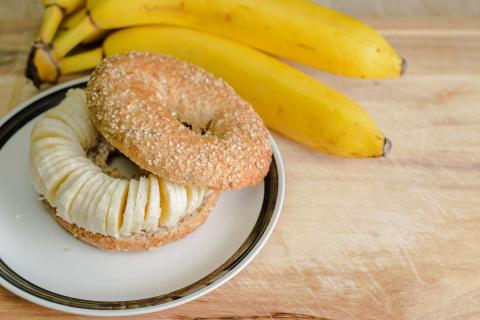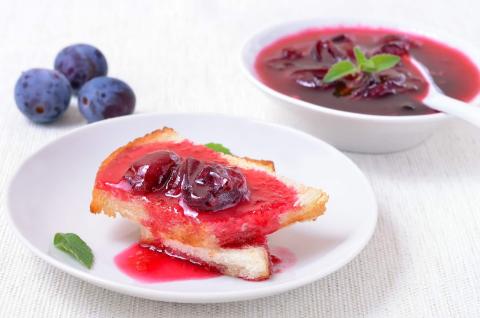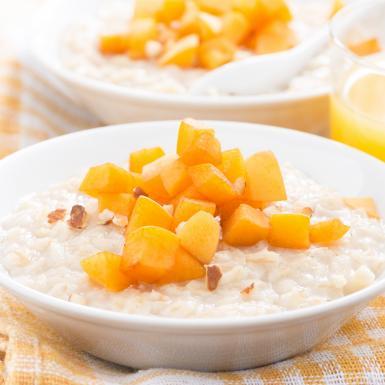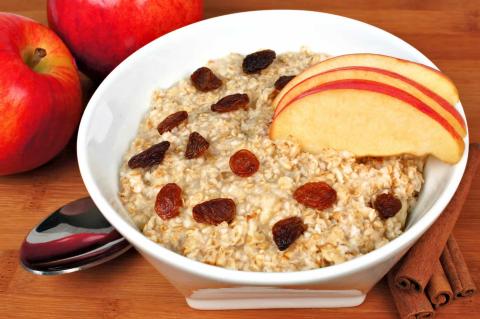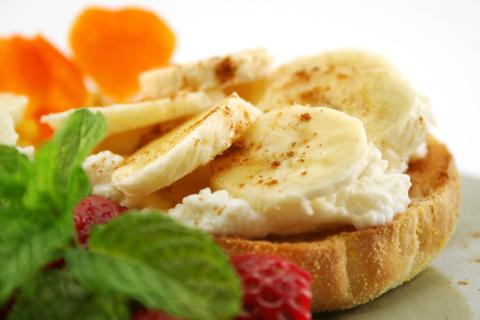- 1 (100g) Banana
- 2 Medium Eggs
- 2 Heaped tablespoons (60g) Plain Flour
- (1g) Cinnamon
Ingredients
Allergy Disclaimer
Always check the label of each ingredient for allergy warnings.
Method
- Peel the banana and place in a bowl, then mash with a fork.
- Crack the eggs into the bowl and mix well. If you have one, use an electric whisk or blender at this stage.
- Once the mixture is a smooth consistency, gradually add the flour (use a sieve if you have one).
- When flour is mixed in fully, heat a non-stick frying pan on a medium heat.
- Pour 1/4 of the mixture into the pan making sure the pancake isn't too thick but also doesn't fill the whole pan. When golden brown, flip with a spatula or knife and cook on the other side.
- Repeat for each pancake. Depending on the size of your frying pan you may be able to cook more than one at a time. When removed from the pan sprinkle with cinnamon.
- Pancakes can be enjoyed hot or cold.
Time Saver Tips
Prepare in advance and store in an airtight container.
Cost Saver Tips
These pancakes are a good way to use up any overripe bananas.
Tips for Kids
They'll enjoy mashing, mixing and flipping! Try making the pancakes with wholemeal flour to up the fibre content. And serve them with the kids' favourite fruit to boost their five a day.
Nutritional Information
Based on a single serving of 61g (% of an adult's reference intake)
Energy
109 kcals ( 5 %)
460 kJ ( 5 %)
Fat
0.7 g ( 4 %)
Saturates
17.8 g ( %)
Sugar
5.3 g ( 6 %)
Salt
0.1 g ( 2 %)
Detailed nutritional information
| Per 100g | Per 61g serving | |
|---|---|---|
| Energy Kcals | 178 | 109 |
| Energy Kj | 754 | 460 |
| Protein | 7.9 g | 4.8 g |
| Total Fat | g | g |
| Saturated Fat | 1.2 g | 0.7 g |
| Carbohydrates | 29.2 g | 17.8 g |
| Total Sugars | 8.7 g | 5.3 g |
| NSP Fibre | 1.7 g | 1 g |
| Sodium | 64 mg | 49 mg |
| Salt | 0.2 g | 0.1 g |
Find out about nutritional labelling
Nutrition labels on the front of packaging
- Most of the big supermarkets and many food manufacturers display nutritional information on the front of pre-packed food.
- Front of pack nutrition labels provide information on the number of grams of fat, saturated fat, sugars and salt and the amount of energy (in kJ and kcal) in a serving or portion of a recipe.
- The labels also include information about reference intakes (expressed as a percentage) which are guidelines about the approximate amount of particular nutrients and energy required for a healthy diet.
- The colour coding tells you at a glance if the food has high (red), medium (amber) or low (green) amounts of fat, saturated fat, sugars and salt.
- The more greens on the label, the healthier the choice
- Amber means neither high nor low, so you can eat foods with all or mostly ambers on the label most of the time.
- Reds on the label means the food is high in that nutrient and these are the foods we should cut down on. Try to eat these foods less often and in small amounts.
Food shopping tips
If you’re trying to decide which product to choose, check to see if there's a nutrition label on the front of the pack. This will help you to quickly assess how your choices stack up. You will often find a mixture of red, amber and green colour coding for the nutrients. So when you're choosing between similar products, try to go for more greens and ambers and fewer reds if you want to make a healthier choice.
 Activities & Play
Activities & Play Behaviour
Behaviour Childcare
Childcare Development & Growing Up
Development & Growing Up Family, Friends & Relationships
Family, Friends & Relationships Feeding Your Baby
Feeding Your Baby Food & Eating
Food & Eating Health & Safety
Health & Safety Mental Health & Wellbeing
Mental Health & Wellbeing Money & Work
Money & Work Online Behaviour & Safety
Online Behaviour & Safety Pregnancy & First Days
Pregnancy & First Days School & Education
School & Education Sleep
Sleep



